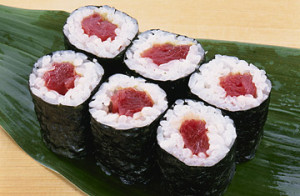I like sushi, but I’m picky about where I eat it.
I avoid places that use ground tuna or back scrape (which I learned about after a 2012 Salmonella outbreak). But a current outbreak is making me evaluate my choice to eat any raw fish dish. According to CDC over 50 cases of a unique Salmonella paratyphi B variant are likely linked to tuna sushi, especially spicy tuna sushi which is usually ground.
There are lots of pathways for Salmonella to get into sushi tuna. The pathogen could have been introduced on a fishing boat, in a processing plant, during packaging or in transport. Hygiene, cross-contamination or sanitation are all a possibility – and that’s what I told Rachael Ratner of Live Science.
Raw tuna is the suspected source of a new outbreak of Salmonella, but how does tuna become contaminated with the bacteria in the first place?
It’s not typical for fish in a natural environment to harbor Salmonella, the way it is, say, for cows to harbor E. coli in their guts, said Benjamin Chapman, a food safety specialist and associate professor at North Carolina State University.
Although, a 2006 Australian study showed tropical fish aquariums could be a reservoir for Salmonella paratyphi B
Experts say that the Salmonella probably wasn’t living on the fish itself, but rather the tuna became contaminated at some point when the food was being handled.
The Salmonella could come from people who handled the food in a restaurant or a processing facility (processing is likely looking at the illness distribution -ben), and didn’t properly wash their hands, Chapman said.
Because health officials have not identified a specific product tied to the current outbreak, it’s too soon to say how the tuna might have become contaminated.
“The more information that we get about [the product], the easier it would be to look for contamination roots,” Chapman said.
But in general, the risk of foodborne illness is higher with raw or undercooked meats, compared with cooked meats, Chapman said. That’s because the extra step of cooking can kill potential pathogens. With raw meats, “there’s no step in between handing [and eating] to reduce risk,” Chapman said.
